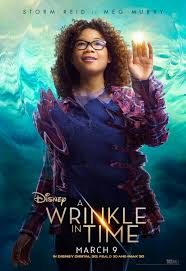My eight-year-old daughter and I left the theater and walked into the bright afternoon sun holding hands. We’d just seen A Wrinkle in Time. That’s a pretty good way for a dad to finish a movie about a daughter who travels billions of light years to rescue her less-than-perfect father from the clutches of evil.
As she clenched my hand, she asked, “Dad, would you say that was a movie about self-discovery?”
“That was part of it. What do you think Meg discovered?”
“That who she is is who she was meant to be.”
Pretty good, I thought. “And who she is is worthy—and capable—of love, right?”
She just squeezed my hand and smiled.
But I bet there were some moviegoers not smiling, disappointed that the explicit Christian message of Madeleine L’Engle’s book morphed into the gospel of Oprah: You are good enough, so believe in yourself.
Though there was more to the movie than that, I can still imagine their whining that Jesus wasn’t mentioned, as he is in the book. Buddha, Rumi, Einstein, Mandela, yes—but Jesus? No.
But that didn’t bother me. For me the question is whether the message of the movie is one I want to shape the mind and the heart of my daughter. To which I answer: Yes.
Worthy of Love
As in the book, Meg must discover that she is worthy of love, despite the faults and fears she thinks disqualify her. I cheered when African-American Meg rejected the fantasy of herself conforming to the image society tells her is beautiful, an image that includes having straight hair like my white daughter’s. And I cheered that my daughter finally got to see a courageous heroine who doesn’t look like her.
I know from experience that any of us can mistakenly believe ourselves unworthy of love. We imagine we are not smart enough, athletic enough, beautiful enough, thin enough, rich enough—whatever enough—to fully belong, to be embraced by the human family and by the Love that moves the planets and the stars, a Love at the heart of the book and the movie.
But Meg discovered that she is worthy of love just as she is. And I’m learning that I am. And my daughter got to see what the journey to discover this can look like, and that it’s a journey worth taking.
Warrior of Light
But Meg didn’t just learn that she’s worthy of love. She also found that she’s capable of love, and that such a love as hers can drive back the forces of evil. As one who can love, Meg becomes what Mrs. Whatsit, Mrs. Who, and Mrs. Which call a “warrior of light.” She’s joined a great army. She’s now a participant in a light that is greater than her, a light that is laboring to banish evil from the cosmos.
It’s a calling I face every day: Don’t just bask in the light of love, like a cat curled up on a warm windowsill, but love—love fervently, actively, persistently. And it’s a call I hope my daughter is hearing. Encompassed by love, she too can love in simple, poignant, powerful ways.
Who knows what hope an eight-year-old’s love might unlock in this world?
The Name of the Light
My daughter woke up early the other morning and caught me in prayer. I was reading the assigned text for the day from the third chapter of John, the familiar passage about a God who loved a cosmos enough to send a Son.
The passage ends with a contrast between the way of light and the way of darkness. Those who follow the light experience the joy of knowing their “deeds are done in God.”
I gestured for her to join me in the La-Z-Boy. She walked over in her orange Halloween pajama bottoms, a too-large flannel shirt, and a menagerie of stuffed animals in her arms. When she climbed into my lap, I said, “Listen to this. I think it might remind you of the movie we saw.” And I read aloud the verses from John’s Gospel.
When I finished, she looked up at me and smiled knowingly, just as she did in the parking lot after the movie. She is loved. She is capable of love. She can be a warrior of light. And she knows it.
And she knows the Light’s name. She doesn’t need Hollywood to tell her that.
The Rev. Dr. L. Roger Owens is associate professor of Christian spirituality and ministry at Pittsburgh Theological Seminary and teaches courses in the MDiv, Doctor of Ministry, and Continuing Education programs. Before coming to PTS he served urban and rural churches for eight years in North Carolina as co-pastor with his wife, Ginger. He has written multiple books including The Shape of Participation: A Theology of Church Practices which was called “this decades best work in ecclesiology” by The Christian Century.


Nice read
In the event the gamer is shifting his cards, we may not have the ability to precisely
learn the cards the gamer is holding.
hello
A post that really catches my attention, reading this content made me reflect on my whole life, thank you!